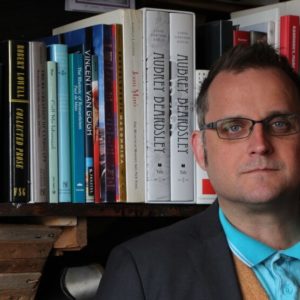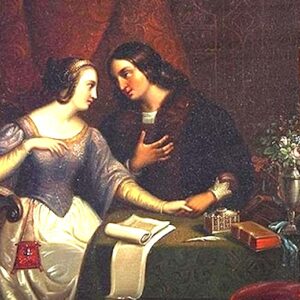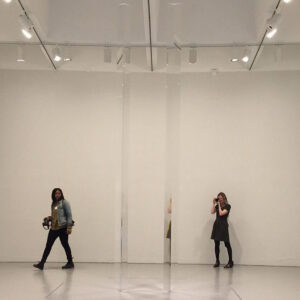We recently spoke with author Morgan Meis about his new Slant book, The Fate of the Animals.
With the publication of The Fate of the Animals, your “Three Paintings Trilogy” is beginning to take shape. So the question arises: what could possibly link paintings as different as Rubens’s Baroque The Drunken Silenus (covered in the first volume) and Franz Marc’s modernist The Fate of the Animals? Is it all subjective—or are there truly things in common here?
There is a certain amount of trust here. I mean that I have to trust myself, and more importantly to trust forces that are beyond myself, circumstances and life events that led me to be interested in these two paintings, and then I suppose the reader has to trust me. I’m pulling on various threads here. There’s no obvious, objective reason why The Drunken Silenus and The Fate of The Animals are related. They really are completely different paintings. And I did not come to either of these paintings with a pre-established grand theory as to why I am writing about them or what they prove about art, culture, history, philosophy, life, or anything else.
But I was drawn to both these paintings, in many ways despite my conscious intentions. I was never a huge fan of Rubens and I never considered Franz Marc to be an especially important painter. Nonetheless, just by stumbling into a relationship with both these paintings, and I think the stumbling is crucial here, both paintings started to reveal depths to me. The more I looked and thought and explored, the more there was. It was a magical and even somewhat disconcerting experience for me. I was carried into the writing by the paintings themselves, if I can put it that way. And I think one thing, at the very least, is that both paintings seem to tackle root questions about what painting does, or can do, or should do, and then more deeply, about what art itself is supposed to do and maybe about what anyone or anything is supposed to do, or become, or be.
When we encounter a visual artwork, we’re used to hearing about its formal properties (brush strokes, composition, etc.) and the historical and cultural context in which it was made, perhaps even its political ramifications. But you go a step further and use visual art as a way to philosophize. How does that work?
I am interested in brush strokes and composition and all those sorts of things. The way that Rubens, for instance, manages to get Silenus to be teetering and almost spilling out of the painting is a technical feat of not inconsiderable proportions, and it has an important effect. It makes the painting feel more, I don’t know, vital than it would otherwise feel.
But that is the point. Beyond being pictures, paintings become something in the world. They impact the world, the people who look at them, feelings, ideas, a day. A painting changes a room. For a person, seeing a certain painting at a certain point in one’s life can be transformative. So, literally, the painting has altered a person or another object or a place.
You can think of this impact in small terms and in grand sweeping terms as well. It is hard to imagine the French Revolution, for instance, without seeing David’s paintings. They are it, in some ways. The more I look at a painting the more I see it as an imposing sort of thing. It makes a claim about how the world is, or ought to be, or, maybe more to the point, really is. This is philosophy, but philosophy done at the visceral, sensual level. Philosophy of the gut.
You said you never considered Franz Marc an important painter. But in the book you speak of his powers of prophecy, not just in the sense of predicting the future (the advent of World War I, say) but in a larger sense. But we also live in an age that has downplayed the role of the artist, seeing her as more of a reflection of cultural or political power. Yet you seem to retain a “high” view of the individual artist’s place in the world….
When I say I never considered Marc an important painter I just mean that I was never drawn to his paintings at first glance. He seemed a second-rate German Expressionist to me. I don’t know, maybe he is. But I don’t really care how he “ranks” because when I discovered his amazing letters, I was forced to look at the paintings again. My eyes were opened. I realized that his paintings are prophetic in that they don’t just want to look nice, or initiate a style, or play a role in the culture at large. They are paintings that cry out from somewhere else, from out in the desert somewhere.
Marc was painting in the way that Ezekiel was eating scrolls. These are paintings that have something to show us and it takes real struggle and work and looking and thinking and feeling to get to where Marc was trying to take us. Marc didn’t paint to contribute to the culture, to be a part of it, he painted as an act of war, to blow a hole in the culture. This is something artists can do. It is intense and scary. We do live in an age that has often sought to downplay the role of artists, let alone prophets. But Franz Marc did not agree. I find myself deeply moved by his disagreement.
Isn’t there a deep ambiguity in figures like Marc, whose yearning for some sort of apocalypse—a European Doomsday—has on the one hand a mystical dimension, a desire for a culture in crisis to be confronted with the truth of its own loss of the soul—and on the other hand feels like it is just a horrific, bloody death-wish? How do you feel your argument navigates that ambiguity?
Yes, there is a deep ambiguity with Franz Marc and you express it well. The fact is, both those impulses exist in Marc’s art and in the things he wrote in his wartime letters. I wonder if something in the prophetic imagination is always bound up with this dark side, with these shadows. In fact, the forthcoming third book of The Three Paintings trilogy explores this very problem in more depth and through the harsh-yet-beautiful paintings of Joan Mitchell. So, you know, stay tuned for more.
But to answer the latter part of your question, I’m not trying to endorse or condemn when it comes to Franz Marc, or in my approach to criticism in general. I’m interested in showing things. I’m interested in uncovering what is already there, laying it bare. I find Marc’s paintings and letters to be astounding works of art. But they are also terrifying. To take Marc seriously is also to be deeply discomfited by him. In my book, I’m not trying to smooth that over or apologize for it. I’m trying to make it worse.
OK, fair enough. Let’s end with an impossible question. (We suspect you like impossible things.) Since this book (and the trilogy as a whole) is so difficult to categorize (a good thing!), it would still be helpful if you could just say why you hope someone might pick up these books. Why take the leap?
Well, my heart and soul are in these books. Everything that I care about and wrangle with and struggle to think about, to understand, to experience, and to feel. The books also showcase a style of writing and of making art, a way that cost me a fair amount in blood, sweat, and tears and which also cost me decades of toil and many, many dead ends and failed attempts. So, if you’re interested in seeing what that looks like…. If you’re interested in seeing a person’s insides vomited out into a book, then this could be worth reading.
Also, it’s funny. Occasionally outrageous. Not boring, I would say. When I read The Fate of The Animals I think to myself, “yes, that’s what I have to offer, every bit of it.” I have read things in my life that convinced me I am not alone and that the struggles of being alive and of what it might really mean to be alive are shared by this other person, who has spoken to me across some anonymous divide. I think of these books as my attempt to do that very same thing, to participate in that sacred sharing. May it be so.





